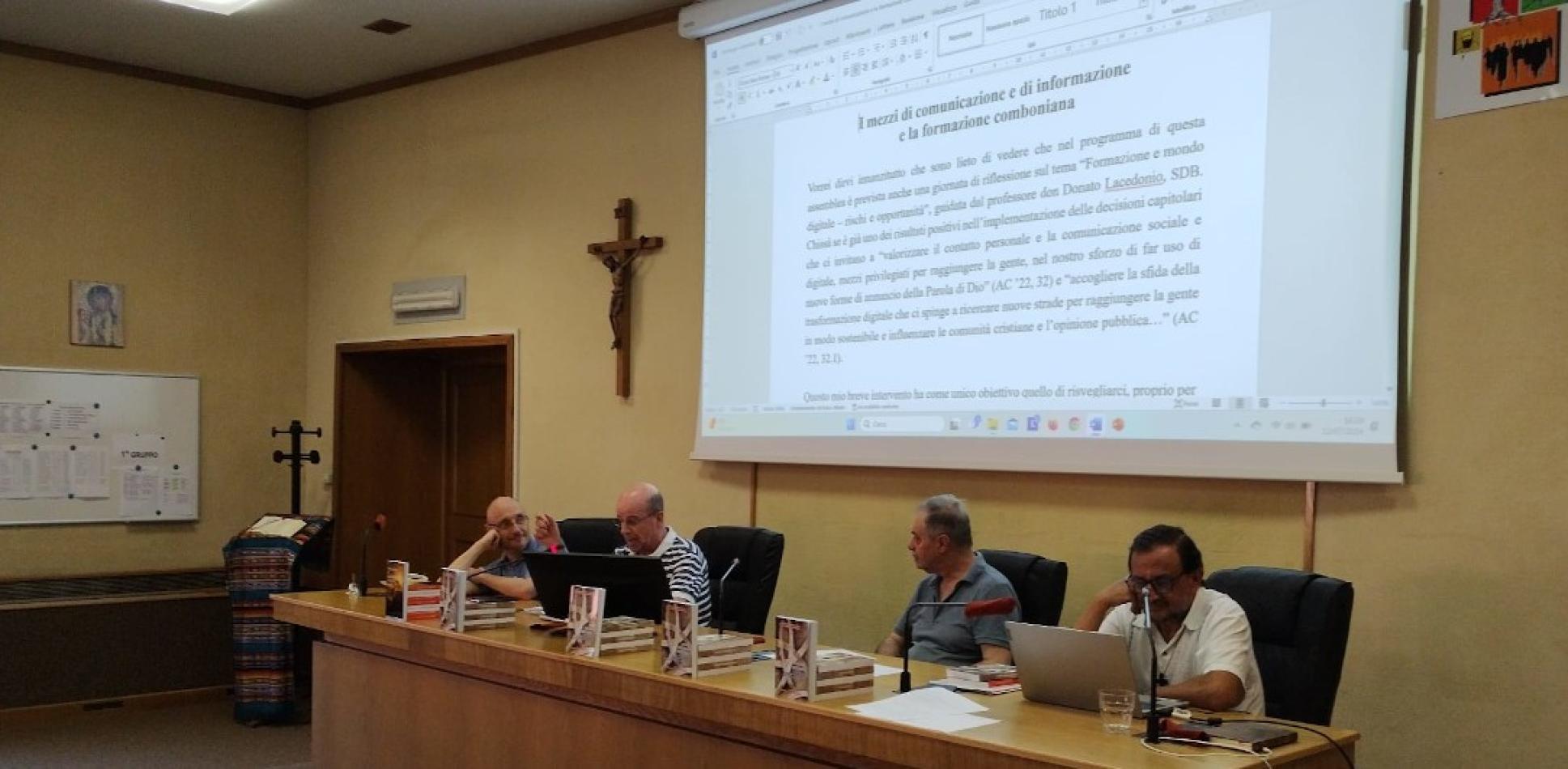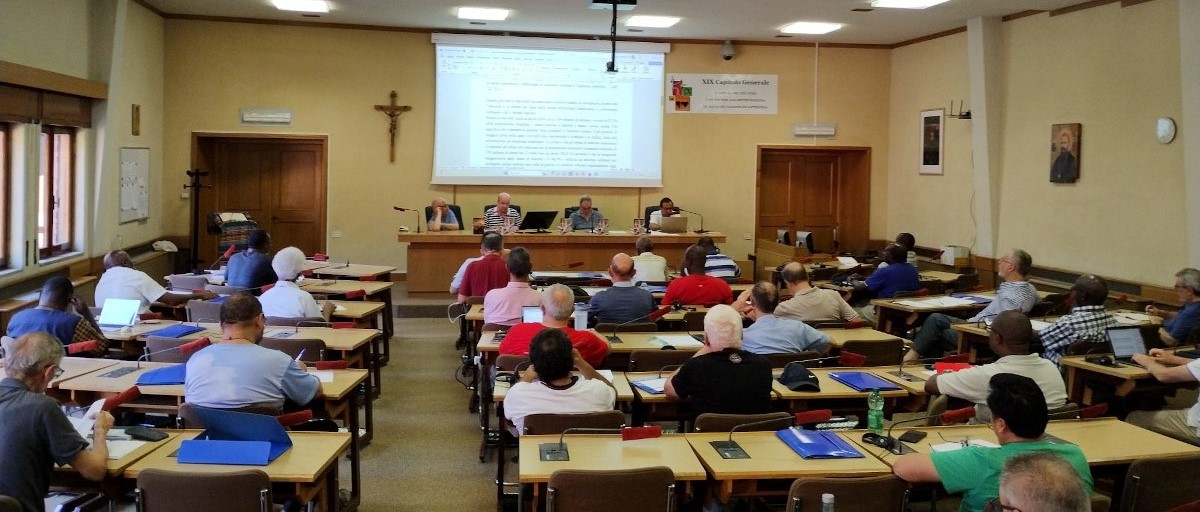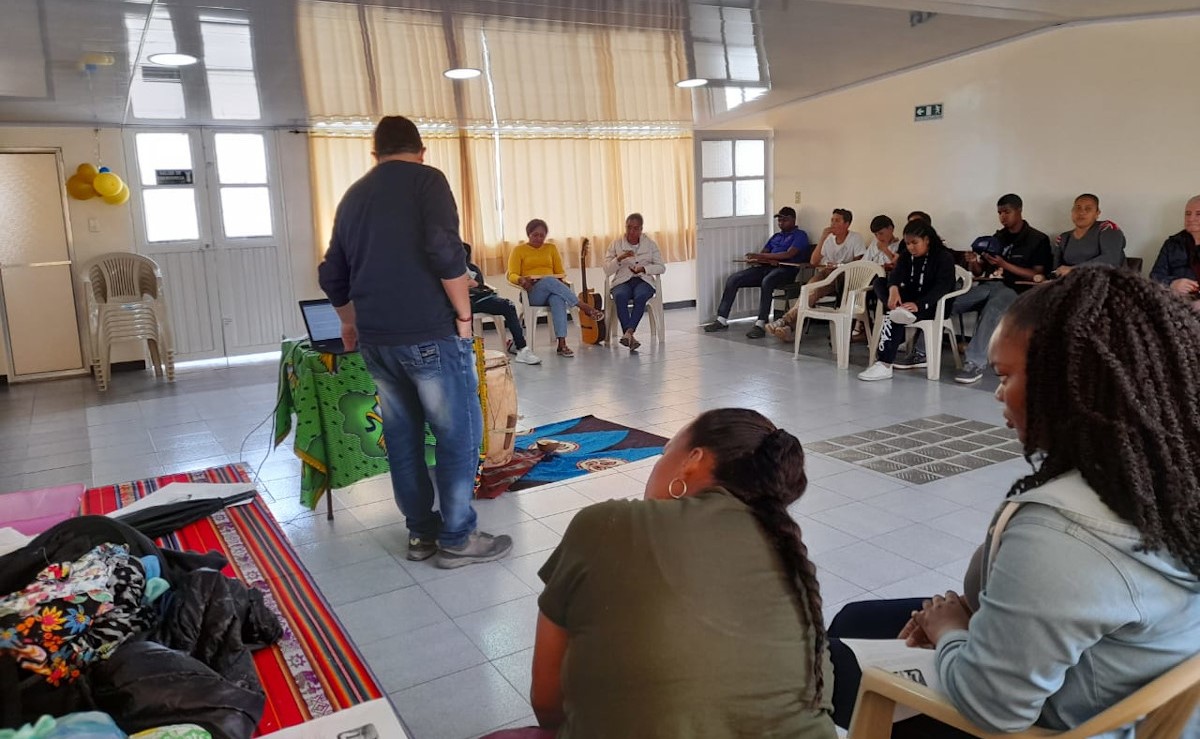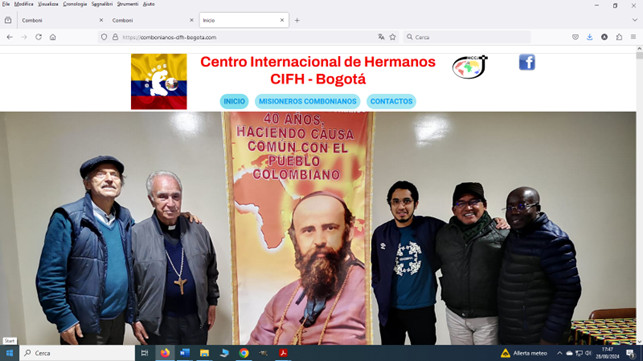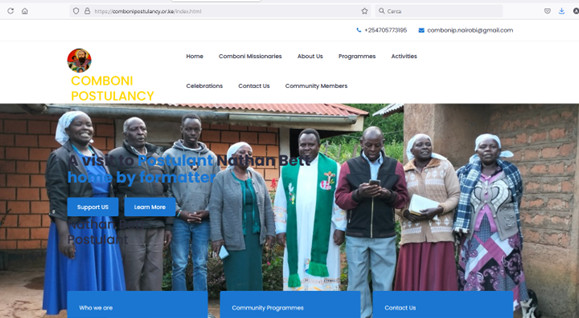Daniel Comboni
Comboni Missionaries
Institutional area
Other links
Newsletter
Tuesday, September 3, 2024
On 12th July 2024, Father Arlindo Pinto, Director of the Communications Office at the General Curia in Rome, was invited to speak to the formators of the Comboni Institute gathered at their General Assembly for Formation, held in Rome from 8th to 27th July. The theme chosen by Father Arlindo was: ‘The importance of the use of the media and information in Comboni formation’. While writing the text of his talk, Father Arlindo carried out a survey to find out how many of the 49 Comboni formation communities publish a bulletin or a newsletter on a regular basis or are present on the Internet or other digital platforms. Below, we publish the text of his talk and the results of the survey he conducted. [See attachments]
The Media and Information
in Comboni Formation Centres
1. Communication and Information Media and Comboni Formation
The purpose of my contribution is to awaken our attention to the urgent and serious issue of how the missionary formation proposed in our postulancies, scholasticates and International Brothers’ Centres (CBC or CIF) is combined with the role played today by the means of communication and information and the entire digital world.[1]
According to data published at the beginning of April 2024, about 5.44 billion people (i.e., 67.1% of the world’s population) have access to the Internet and use social media. The number of people ‘not connected’ to the Internet has dropped to 2.66 billion, mostly living in South or East Asia and Africa.
Other information seems important to me: Internet users continue to grow (178 million new users in the 12 months to April 2024); most Internet users (96.3%) use a mobile phone to go online at least once a day; mobile phones now account for the largest share (57.8%) of the time we spend online and 60% of global web traffic.[2]
What lies behind these figures, along with the growth of social media and the spread of artificial intelligence – true ‘new signs of the times’ – has changed our reality in many ways we could never have imagined; indeed, it has created a new world and a new culture, to the point that we are already talking about a ‘new digital continent’. It has also opened new doors for formative, teaching and learning processes, and created a new online space, a new ‘territory’ for our pastoral, vocational and missionary activities.[3] It must be said, however, that we cannot be adequately present in the new digital culture without first understanding it.
As Comboni formators, we know that this new world cultural reality requires adequate preparation and formation, which we are called to acquire if we want to enter it and create new styles of evangelisation, vocational promotion and digital mission.[4]
I am aware that I am not telling you anything new. Yesterday, Father José de Jesús Villaseñor Gálvez, General Secretary for Formation, listed for you the general motions of the APDESAM (Assembly of the Provincials and Delegates of English-Speaking Africa and Mozambique) Formation Assembly held in July 2023 in Nairobi. One of them struck me in particular: “The missionary and responsible use of the mass media and the Internet to carry out missionary animation, vocational promotion and the procurement of material resources is recommended”.
I am certain that the vast majority of us – especially the younger ones, postulants, novices and scholastics (the so-called ‘digital natives’) – are now ‘inhabitants’ of this still rapidly evolving digital environment. We can no longer avoid and ignore it! Instead, we are called to become missionaries of this ‘digital continent’ and ‘online formators’, animated by the action of the Spirit, following the example of the Lord Jesus, the ‘Master of Communication’, and of our Founder, Saint Daniel Comboni, himself an unsurpassed ‘communicator’.
One of the most innovative means of communication that has revolutionised our way of communicating and living and cannot be forgotten is the mobile phone (smartphone). This medium has not only expanded the space of human relationships and shortened connection times, thanks to digital technologies, but has become an inseparable extension of our bodies. We can forget everything but the mobile phone! And if it is true that the mobile phone is now an (almost) natural part of our bodily being, this means that ‘it is (almost) forbidden to ban it’. We just have to learn how to use it. I repeat: it is not the electronic media (mobile phones, tablets, laptops...) that are the problem or the main challenge, but our training in their daily use.
I have my own personal ‘theory’ on the use of the smartphone, as of all other digital media: ‘the smartphone is like the knife’. The knife is a useful and necessary ‘good’, but it can be used to do both good and evil. The same applies to new media: they can be both bad and good; one must learn to use them well. In a technological world such as ours, where human connection is a constitutive condition of our collective life, the best and most effective way to assimilate and ensure the proper use of digital media necessarily passes through a serious and comprehensive education in their use, both at a basic academic level and in lifelong learning. It is not difficult to deduce that the poorer such education is, the greater the lack of responsibility and critical thinking in the way they are used. Only proper and continuous training in their use will provide us with both.
Therefore, Educating ourselves in the use of the media and information and communication in general means, first and foremost, educating ourselves in critical thinking and discernment. And it is up to the Institute and to you formators to ensure a ‘digital literacy’, providing your ‘formandi’ with the appropriate tools and criteria (technical, scientific and ethical) on how to deal with the new technologies and the avalanche of information that invades us on a daily basis.
2. Media research in Comboni houses of formation
As I thought about what I could tell people like you who are in charge of formation in our Institute about the importance of today’s means of communication and information, particularly in the formation context of our young candidates, the curiosity arose in me to know how many Comboni communities are engaged in the field of formation and how many of them publish a newsletter (or other means of communication) or are present on the ‘digital continent’ in an official way. I could do no more than patiently go and check how many have one or more official media (printed or digital on the Internet) or an account on one of the many digital social platforms.
In reality, a greater investment in this area of communication and a more significant and constant presence in the many digital information dissemination platforms would help us to spread initiatives, experiences and pastoral activities, both internal and external – in terms of evangelisation, missionary animation and vocational promotion – not only with the various communities of the Institute, family members, friends and benefactors, but also to reach a wider audience and, above all, young people. To facilitate the reading of the data collected, I have organised them into two Tables that I present below.
2.1 Presentation of the data in the tables
Table 1 shows the data concerning the 28 Comboni circumscriptions (I have also included Poland and Curia/General Administration, as if they were circumscriptions). Of these, twenty-four (24) have at least one formation community; four (4) – Ecuador, London Province, Poland and Portugal – do not. The ‘formation communities’, including the Centre for Ongoing Formation (CFP) of the General Curia in Rome, number 49, divided as follows:
A) Formation level
|
Propaedeutics/minor seminars |
10 |
|
Postulates for priests |
14 |
|
Postulates for brothers |
2 |
|
Novitiates |
8 |
|
Scholasticates |
12 |
|
Brothers’ International Centres (CIF) |
2 |
|
Centre for Ongoing Formation (CFP) |
1 |
B) Continent or subcontinent level
|
Anglophone Africa + Mozambique (APDESAM) |
23 |
|
Francophone Africa (ASCAF) |
11 |
|
America/Asia |
11 |
|
Europe |
4 |
Of the 49 communities, 29 (59.2%) have one or more means of communication, while 20 (40.8%) have nothing, not even the e-mail. Of the latter 20, 7 are propaedeutics or minor seminaries, 6 are postulancies, 5 are novitiates and 2 are scholasticates. By continent or subcontinent, 52.2% of the APDESAM communities have no official means of communication, 45.5% of those of ASCAF, 25% of those of Europe, and 18.2% of those of America/Asia.
If I am not mistaken, of the 8 novitiates, 5 do not even have e-mail, 2 have only e-mail, and 1 has e-mail and Facebook. Of the 12 scholasticates, 2 have no e-mail (Chicago and Graz, recently opened); 1 of the 2 CIFs has e-mail only.
In terms of the most used means of communication: 19 communities have an official e-mail; 9 publish a printed bulletin, with varying regularity; 3 have a website; 19 are on Facebook; 12 use group WhatsApp; 4 are also on other platforms (1 uses Intranet) or social networks (Instagram, YouTube, TikTok).
Of the 49 formation communities, only 2 (1.96%) have their own website and one (the CFP) has its own space on the Institute’s official website.
From the 29 formation communities that have one or more means of communication, two good examples deserve a mention, particularly for the website: the Nairobi postulancy – (the only community that has all the means mentioned in the questionnaire: website, bulletin, Facebook, e-mail, WhatsApp, YouTube and TikTok) – and the CIF in Bogotá (website, Facebook, e-mail, and WhatsApp).
Both websites – https://combonipostulancy.or.ke/ (Kenya) and https://combonianos-cifh-bogota.com/ (Colombia) – are creative and respond to the four main reasons why it is important and fundamental to be visible on the digital continent: evangelisation, missionary animation, vocational promotion and fundraising.
The Centre for Ongoing Formation (CFP) in Rome has its own news section on the Institute’s official website (https://www.comboni.org/categorie/291), which is also shared by the General Secretariat for Formation.
Table 2 offers the names (titles) and main references of each of the media on which the 19 training communities are present.
2.2 Conclusion
From the data I was able to gather and, in particular, from the conversations I had with the participants at the General Assembly, I think I can say that a large part of the formators are already more than convinced that the topics of communication, information and the use of digital media cannot be absent either in the various stages of the formation process offered to our candidates or in the ongoing formation initiatives proposed to all the confrères. But recognising their importance is not enough. In the short term, concrete formation projects must be implemented in this regard.
I think I can say, without a shadow of a doubt, that our formative communities (in all their phases) still have a very weak presence on the ‘digital continent’, although, in my opinion, they already have the capacity to be much more present at all levels. All they need is to want it!
We can no longer doubt that modern means of communication and new digital platforms offer excellent conditions and open doors for those who want to use them for a more widespread evangelisation, for a more incisive missionary animation and vocational promotion, and for ingenious fundraising.
Ultimately, the worldwide cultural change generated by the new digital communication and information technologies can no longer be discarded or ignored in our formation processes.
2.3 Suggestions
I would like to conclude these reflections with some suggestions, considering some good examples already present in several formation communities (see Tables 1 and 2).
2.3.1 Every formation community should have (in an official way) and communicate to everyone at least the following: an e-mail address, a telephone number and two ‘publications’ (one paper and the other digital). It is advisable not to tie the ‘publications’ strictly to individuals, nor to use private telephone numbers of ‘formandi’ or formators, in order to avoid problems or inconveniences when transferring people from one community to another.
2.3.2 In addition to the various services already carried out by the young formandi in each formation community, a ‘communication service’ should be set up, managed by some people in charge with the task of publishing information on their internal and external activities. A ‘communication plan’ should be drawn up, listing the means of communication chosen, and clarifying the purposes for which they are used, the recipients, the content and formats to be favoured (‘news’, ‘short vocational stories’ [storytelling], photos, audio, video, simple clips...), the frequency, and the persons responsible for the various tasks to be carried out. The important thing is to start! And it is guaranteed that ‘new talents’ will be discovered among the formandi, capable of becoming ‘true craftsmen’, and even ‘authentic artists’ of communication.
2.3.3 Listening to some formators, especially of novitiates, there would even be a ban (partial or total) on the use of smartphones. Ban? We are not dealing with ‘forbidden fruit’ displayed on the market of the Internet world. If this is the image we spread of the digital world, then let us not be surprised if the young formandi surpass us in deceiving our ‘guard’ in order to enjoy the ‘forbidden fruits’. There has been no shortage of formators who have candidly confessed that their young people, in addition to the smartphone handed to them, have a second one with an accomplice friend, outside the community, to be used at the appropriate time. Such behaviour should be avoided. And it could be avoided if, instead of banning, we opted for serious and continuous education on the benefits and harms of using these modern devices. This seems to me to be the logic behind the Educative Model of Integration (EMI) adopted by our institute.
2.3.4 The almost complete absence of websites in the formation houses could be remedied in a rather simple way. Most Comboni circumscriptions already have an official website (only three do not). The easiest solution is to create a ‘section’ or a space reserved for formation communities (this is the case of the CFP in Rome), especially at the novitiate and scholasticate/CIF levels, leaving both the content and the format of the section to the competence and responsibility of the formators and their young people.
Father Arlindo Pinto, MCCJ
Communications Office Director
Rome, August 2024
Notes:
[1] I am happy to see that the programme of this Assembly includes a day of reflection on the theme ‘Formation and the digital world – risks and opportunities’, animated by Professor Donato Lacedonio, SDB. I want to believe that this sensitivity shown by the Assembly organisers is already one of the positive results of the process of implementing the guidelines and commitments defined by the last General Chapter. The following two texts are significant: “Guideline 4: We value missionary animation, personal contact, and social and digital communication, privileged means of reaching people, in our effort to make use of new forms of proclaiming the Word of God... We commit ourselves to accept the challenge of digital transformation, which urges us to seek new ways to reach people in a sustainable way and to influence Christian communities and public opinion, collaborating with existing networks and territories” (AC ’22, 32; 32.1).
[2] We find these data, and many others, on the digital world constantly updated on the Digital Around the World website, accessible at: https://datareportal.com/global-digital-overview.
[3] In this regard, it is worth mentioning the example of the Mexican diocesan priest, Father Heriberto García Arias, who works in Rome at the Dicastery for Communication, in contact with other ‘digital missionaries’. The website of the Italian newspaper Avvenire reported on this: “I cannot say for sure whether the world ranking of digital missionaries is still that of 2023 or whether the ranking needs to be updated, but certainly the social numbers of this 36-year-old Mexican presbyter are respectable: 1.8 million followers on his TikTok account, 252 thousand on his Instagram account, 75 thousand subscribers on his YouTube channel, 65 thousand on his Facebook page’ [Mocellin, G. (4th July 2024). “Digital missionaries. The world’s No. 1 Catholic influencer: beautiful, good and aware”. Accessible online: https://www.avvenire.it/rubriche/pagine/missionari-digitali-3-luglio-2024]. This is the link to Father Heriberto García Arias’ YouTube account: https://www.youtube.com/channel/UCMcxV90TTvf1c4P0OpEJ_ww.
[4] For those interested in delving into this topic from a Comboni perspective, I point to two recent studies-reflections that have been published on www.comboni.org and in our MCCJ Bulletin. The first, entitled ‘The Ethical Challenges of Communication on the threshold of the 21st Century’ (MCCJ Bulletin n° 297, October 2023, pp. 40-122) – accessible on the site in Italian, English, Portuguese and German – is a scientific reflection on the contemporary reality of communication and information, especially from the ethical point of view, and on how to disentangle and defend oneself in this world of disinformation, hackers, fake news, communication monopolies, data (Big Data), algorithms and artificial intelligence. The other text – accessible on the site in Italian, English and Spanish – is a research on the communication and information media, internal and external, of the Combonian Institute: ‘Comboni Media and Missionary Animation – from the XIX General Chapter to the 2023-2028 Six-Year Plans’, in MCCJ Bulletin no. 299, April 2024, pp. 29-55.
Tabella_1_comunicazione_case-di-formazione_IT
Tabella_2_comunicazione_case-di-formazione_IT
I mezzi di comunicazione e la formazione comboniana_ES
I mezzi di comunicazione e la formazione comboniana_FR
I mezzi di comunicazione e la formazione comboniana_IT
I mezzi di comunicazione e la formazione comboniana_PT
The Media and Information in Comboni Formation Centres-English
Table 1_Presence of the media in Comboni houses of formation_EN
Table 2_Means of communication in Comboni houses of formation_EN

